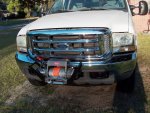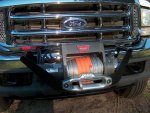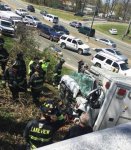You are using an out of date browser. It may not display this or other websites correctly.
You should upgrade or use an alternative browser.
You should upgrade or use an alternative browser.
Point Five Ambo Build
- Thread starter patoz
- Start date
patoz
Expedition Leader
There is still one thing I'm uncertain about. That winch comes with 125" of steel cable normally, and I'm changinging it to 100' of synthetic. Everything I've read says it will fit, but that sure looks like a big pile of line to get on that awfully small drum. We have two days of rain coming up (again), so I won't know until this weekend.
OK, it's Monday and not the weekend but I did get the line spooled onto the winch and it held the whole 100' of 3/8" line perfectly!


The battery cables are just connected temporarily so I could operate the winch. The finished product will consist of a second battery, once I find a location for it, that the winch will be connected to, and it will be charged using a Blue Sea Systems 12V DC 500A Automatic Charging Relay with Manual Control (ACR) - 7622. The 175A Anderson Connector will probably be mounted behind the winch in a bumper opening on a bracket, along with another connector for the on-dash winch controls, but that location is not set in stone yet.
The battery cables are just connected temporarily so I could operate the winch. The finished product will consist of a second battery, once I find a location for it, that the winch will be connected to, and it will be charged using a Blue Sea Systems 12V DC 500A Automatic Charging Relay with Manual Control (ACR) - 7622. The 175A Anderson Connector will probably be mounted behind the winch in a bumper opening on a bracket, along with another connector for the on-dash winch controls, but that location is not set in stone yet.
Every step, progress...
rlrenz
Explorer
Every step, progress...
Slowly, and painfully...
(for those of us whose bodies talk to us, and the conversations NEVER start with "Good Morning!")
patoz
Expedition Leader
Yep, little by little!
The next hurdle is to find a location to mount the second battery. There is absolutely no place under the hood to mount a second battery. The only other option is putting it outside the frame under the passenger's door. If I put it there, that means buying an AGM Battery ($$) because I'm not crawling under there and removing the battery every month just to check the water levels. A battery watering system would help, but I don't know if they make them for regular 12V lead acid batteries.
One possible option is to remove the AFE Cold Air Intake System I installed, redesign and relocate the intake somehow, and mount the battery in that location. The problem here though is, the filter and box is as big as a battery. The factory airbox uses all of that space as well.




Maybe, it's time for a snorkel...

Seriously though, if anyone knows of an Aux Battery Box or kit that is made for a 2004 F250 Super Duty with the 6.8 V-10 Triton, please let me know.
The next hurdle is to find a location to mount the second battery. There is absolutely no place under the hood to mount a second battery. The only other option is putting it outside the frame under the passenger's door. If I put it there, that means buying an AGM Battery ($$) because I'm not crawling under there and removing the battery every month just to check the water levels. A battery watering system would help, but I don't know if they make them for regular 12V lead acid batteries.
One possible option is to remove the AFE Cold Air Intake System I installed, redesign and relocate the intake somehow, and mount the battery in that location. The problem here though is, the filter and box is as big as a battery. The factory airbox uses all of that space as well.




Maybe, it's time for a snorkel...

Seriously though, if anyone knows of an Aux Battery Box or kit that is made for a 2004 F250 Super Duty with the 6.8 V-10 Triton, please let me know.
Ideally, you want a dual battery (parallel) setup, to have two batteries that are exactly the same. Combining batteries of different sizes, ages, CCA's, etc., can potentially cause problems. I am not saying it WILL or that it has never been done, but if you are building this as an expo/travel rig, it would be best to spring for two new AGM batteries and be done. For chrissakes, please do not buy anything from Optima if you go the AGM route.
Hawker/Odyssey, Diehard Platinum, Braille, Lifeline and Northstar, among others, make high quality AGM batteries.
Hawker/Odyssey, Diehard Platinum, Braille, Lifeline and Northstar, among others, make high quality AGM batteries.
patoz
Expedition Leader
Ideally, you want a dual battery (parallel) setup, to have two batteries that are exactly the same. Combining batteries of different sizes, ages, CCA's, etc., can potentially cause problems. I am not saying it WILL or that it has never been done, but if you are building this as an expo/travel rig, it would be best to spring for two new AGM batteries and be done. For chrissakes, please do not buy anything from Optima if you go the AGM route.
Hawker/Odyssey, Diehard Platinum, Braille, Lifeline and Northstar, among others, make high quality AGM batteries.
The truck will be used as a tow vehicle for the heavy duty off-road camper trailer I'm building out of the rear half of a Type III ambulance. The range of use will be fairly local and up to 500 miles or less from home in most cases.
Thanks for the heads up, but there seems to be several schools of thought on this matter. I used to think like you do, but learned something new last night. For a typical battery setup, such as what would be used for a house battery bank, the batteries need to be all identical in type, size, and age. However, when using two batteries or battery banks to perform two different functions, and they are being connected/charged via an ACR, the rules change. Please see this thread, Post # 27.
patoz
Expedition Leader
The following is from a traffic accident yesterday on 04/20/2016, involving a Type III Ambulance (which we all have). The driver and patient were killed and the attendant broke his leg when the vehicle crashed into the wall of an overpass on the Southern State Parkway on Long Island. The ambulance was doing a routine transport at the time, and was not running with its lights and siren turned on. Investigators are now trying to figure out what caused the crash, as the ambulance went straight off the road and struck the bridge abutment for no obvious reason.
http://breaking911.com/two-emts-dead-after-ambulance-crash-on-southern-state-parkway-in-ny/
http://newyork.cbslocal.com/2016/04/20/southern-state-parkway-ambulance-crash/
http://abc7ny.com/1300837/
I had emailed this to Bob (The Fam-bulance) late last night, with the intentions of posting it on here also but he beat me to it, so I just copied and pasted it here for everyone I know to see.
Thanks Bob for posting this. I thought about doing it last night but was too tired.
In case anyone is wondering, that is a late model Ford E350 or E450.
The one that crashed is unit 192.

And this is unit 193 at some kind of PR function.

http://breaking911.com/two-emts-dead-after-ambulance-crash-on-southern-state-parkway-in-ny/
http://newyork.cbslocal.com/2016/04/20/southern-state-parkway-ambulance-crash/
http://abc7ny.com/1300837/
I had emailed this to Bob (The Fam-bulance) late last night, with the intentions of posting it on here also but he beat me to it, so I just copied and pasted it here for everyone I know to see.
Anyone who's worked with ambulances knows that the module (the ambulance portion) is built like a brick phone booth, but this became very apparent after Wednesday's New York state accident involving a Type-3 ambulance, and a bridge abutment (my thanks to patoz for this info)
Note that the cab is gone, while the module is intact, and the end doors and side door were able to be opened.
The accident killed the patient, and the attendant broke his leg. The driver was killed instantly. I imagine the engine is in the front of the module or maybe it went back and down under, but it’s sure not where it’s supposed to be.
They were on a routine transfer and traveling with no lights or siren. The ambulance left the road for some unknown reason and struck the overpass wall. Judging by the front end damage, I’m guessing speed was a lot faster than it should have been.
I ran the math, and assuming that the front crumpled about 40", the impact would have resulted in approximately 98 G's at 70 MPH, and 120 G's if the vehicle had been traveling at 85 MPH

Thanks Bob for posting this. I thought about doing it last night but was too tired.
In case anyone is wondering, that is a late model Ford E350 or E450.
The one that crashed is unit 192.

And this is unit 193 at some kind of PR function.

Last edited:
Holy crap. I don't think I've ever seen the front end of a vehicle pancake that bad. I'm surprised the attendant walked away with just a broken leg, and as far as the driver being killed instantly. Ya think?
It sucks that people died, without question, but there is another take-away from this. Look at that module. I don't think there's an off the shelf standard RV industry class C on the planet whose camper section would have withstood that impact without turning into kindling and fiberglass dust. To me that is simply amazing. From those pics it looks as if it survived pretty much without a scratch, at least structurally.
Major thumbs up for Ambo construction.
It sucks that people died, without question, but there is another take-away from this. Look at that module. I don't think there's an off the shelf standard RV industry class C on the planet whose camper section would have withstood that impact without turning into kindling and fiberglass dust. To me that is simply amazing. From those pics it looks as if it survived pretty much without a scratch, at least structurally.
Major thumbs up for Ambo construction.
patoz
Expedition Leader
Tom, did you notice even the doors still opened and closed also?
That's what those modules are designed to do. The frame is basically a roll cage, and the regulations state it must be able to support the entire weight of the vehicle with it sitting completely upside down.
That's what those modules are designed to do. The frame is basically a roll cage, and the regulations state it must be able to support the entire weight of the vehicle with it sitting completely upside down.
Wow... Powerful photos.
First trip I did with my ambo i drove it down a narrow Forest Road and promptly wedged the passenger top corner up into a branch. Kept driving and didn't really notice. Just left a scratch, but mangled the tree limb.
Would've prob. crumpled and splintered a typical RV roof.
First trip I did with my ambo i drove it down a narrow Forest Road and promptly wedged the passenger top corner up into a branch. Kept driving and didn't really notice. Just left a scratch, but mangled the tree limb.
Would've prob. crumpled and splintered a typical RV roof.
Wow... Powerful photos.
First trip I did with my ambo i drove it down a narrow Forest Road and promptly wedged the passenger top corner up into a branch. Kept driving and didn't really notice. Just left a scratch, but mangled the tree limb.
Would've prob. crumpled and splintered a typical RV roof.
The typical RV is a piece of junk as far as quality of construction, but unfortunately they're the only game in town for the average recreational camper. I've owned a few and as nice as they may look and in spite of all the gee-whiz features they might stuff in, quality is at the bottom of the list. Buy anything off the average RV lot, don't care the brand, and I can guarantee you'll be fixing stuff almost immediately. Of course folks that just went out and dropped $60k-$70k on a new spiffy 5th wheel toy hauler don't want to hear none of that. I know, I've been yelled at.
Similar threads
- Replies
- 23
- Views
- 4K
- Replies
- 2
- Views
- 1K
- Replies
- 25
- Views
- 2K


